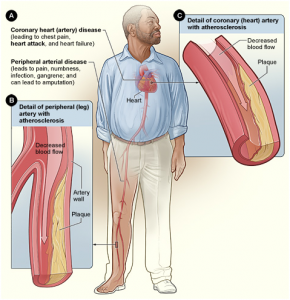 Poor circulation in the feet typically occurs when there is a blockage in the arteries. This common circulatory problem is known as peripheral artery disease (PAD), and it usually affects the extremities, more commonly the legs and the feet. PAD is primarily caused by atherosclerosis, or the buildup of fatty plaque in the arteries. Less common causes of PAD are blood clots in the arteries, injury to the limbs, and unusual anatomy of the muscles and ligaments.
Poor circulation in the feet typically occurs when there is a blockage in the arteries. This common circulatory problem is known as peripheral artery disease (PAD), and it usually affects the extremities, more commonly the legs and the feet. PAD is primarily caused by atherosclerosis, or the buildup of fatty plaque in the arteries. Less common causes of PAD are blood clots in the arteries, injury to the limbs, and unusual anatomy of the muscles and ligaments.
The arteries deliver oxygen and nutrient-rich blood from the heart to the rest of the body. Healthy arteries have a smooth lining that promotes steady blood flow, allowing cells to receive all things necessary to keep the normal function of the body. Problems arise when the arteries become narrowed or blocked due to the formation of plaque inside the walls of the arteries, such as in the case of PAD. This plaque is a sticky substance composed of fat, cholesterol, fibrous tissue, and calcium. Over time the arteries become narrow and stiff, making it difficult for blood to get through, especially when trying to reach the parts that are farthest away from the heart – the feet. The biggest problem with poor circulation is that cells are not getting enough oxygen, and this can cause tissue damage.
While many people with PAD usually have mild or no symptoms, some may experience leg pain with physical activity, such as walking, that often disappears after rest. This is called claudication, and it involves painful cramping of the hip, thigh, and calf muscles. Possible peripheral artery disease symptoms include:
- Leg numbness or weakness
- Lower leg or foot that is cold to touch
- Poorly-healing wound on the toes, feet, or legs
- Change in skin color or shiny skin on the legs
- Hair loss on the feet and legs
- Slower growth of toenails
- No pulse or a weak pulse in the legs or feet
Those who smoke, have diabetes, or are over 50 are at greatest risk for PAD. If PAD is left untreated, a person may develop life-threatening complications that can lead to amputations, strokes, and heart attacks. Medications and lifestyle changes may be recommended as part of peripheral artery disease treatment. Since unhealthy behaviors are contributing factors, learning to manage them is a good starting point to increase blood circulation. This includes getting regular exercise, eating a healthy diet, and smoking cessation. Doctors may also suggest wearing compression garments. Compression increases blood flow, which helps to counteract poor circulation in the legs and feet. Antihypertensive drugs as well as statins are prescribed to lower cholesterol levels. Cilostazol and pentoxifylline may be given to patients with intermittent claudication.
If there is little to no improvement with these efforts, this might indicate a more serious medical condition that requires the care and attention of a physician. In some cases, angioplasty may be performed to open narrowed or blocked arteries. More advanced cases would need bypass surgery to treat severe pain, heal wounds, or save a damaged foot or leg. Like other invasive medical procedures, risks will always be involved, therefore, each patient should have their anatomy and symptoms carefully analyzed in order to create a personalized treatment plan.
While poor circulation isn’t a disease in and of itself, it can be a sign of another underlying health problem. Contact Dr. Ejodamen Shobowale of DeNiel Foot and Ankle Center if you have any concerns about poor circulation in your feet. She’ll take care of your foot and ankle problems and get you back on your feet quickly!
Comments
[…] keeping our feet comfy and safe when it comes to footwear. However, it is crucial to be aware that socks cutting off circulation is a thing, particularly when wearing the wrong socks or wearing them for an extended period of […]
[…] many individuals, poor circulation is more than just a health concern—it’s a daily reality that can impact overall well-being. […]
Comments are closed.